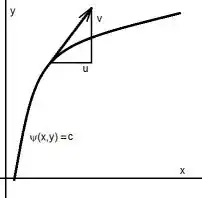Wikipedia references:
<quote>
Streamlines are a family of curves that are instantaneously tangent to the
velocity vector of the flow. These show the direction a massless fluid element
will travel in at any point in time. </quote>
Consider the velocity field $(u,v)$ of a two-dimensional incompressible flow.
Let the family of curves be given by $\;\psi(x,y) = c$ . The velocity vectors are
tangent to these as shown for one of them in the following picture.

Thus, along the curve $\psi(x,y) = c$ , the following equations hold:
$$
\left. \begin{array}{l} \frac{dy}{dx} = \frac{v}{u} \\
d\psi = 0 = \frac{\partial \psi}{\partial x} dx + \frac{\partial \psi}{\partial y} dy
\end{array} \right\} \qquad \Longrightarrow \qquad
\frac{dy}{dx} = - \frac{\partial \psi / \partial x}{\partial \psi / \partial y}
= \frac{v}{u}
$$
Hence, apart from a constant:
$$
u = \frac{\partial \psi}{\partial y} \qquad ;
\qquad v = - \frac{\partial \psi}{\partial x}
$$
But the flow is incompressible, so:
$$
\frac{\partial u}{\partial x} + \frac{\partial v}{\partial y} = 0
\qquad \Longrightarrow \qquad
\frac{\partial^2 \psi}{\partial x\, \partial y} =
\frac{\partial^2 \psi}{\partial y\, \partial x}
$$
Herewith the
conditions for an exact differential equation are fulfilled.
Now solve $\psi$ from:
$$
v\, dx - u\, dy = 0
$$
Example.
As taken from :
Find the velocity of a flow .
$$
u = -\frac{y}{x^2+y^2} \qquad ; \qquad v = \frac{x}{x^2+y^2}
$$
Then:
$$
v\, dx - u\, dy = \frac{x\,dx + y\,dy}{x^2+y^2}
= \frac{d\left( x^2+y^2 \right)}{x^2+y^2} = 0
\qquad \Longrightarrow \qquad
x^2 + y^2 = c
$$
It is concluded that the streamlines of this flow are circles.
Example. Somewhat related to the above one.
$$
u = \lambda\,x \qquad ; \qquad v = \lambda\,y
$$
Then, assuming that $\; x\ne 0$ (i.e. $\,x=0\,$ as a special case) :
$$
v\, dx - u\, dy = 0 \quad \Longleftrightarrow \quad
\frac{y\,dx - x\,dy}{x^2} = - d(y/x) = 0
\quad \Longrightarrow \quad y = c\, x
$$
An integrating factor has been used.
It is concluded that the streamlines of this flow are straight lines
through the origin.
Wikipedia reference:
The electric potential at a point $\vec{r}$ in a two-dimensional
static electric field $\vec{E}$ is given by the line integral:
$$
V = - \int_C \vec{E}\cdot d\vec{r} = - \int_C \left(E_x\, dx + E_y\, dy\right)
$$
where $C$ is an arbitrary path connecting the point with zero potential
to $\vec{r}$. It follows that:
$$
E_x = - \frac{\partial V}{\partial x} \qquad ; \qquad
E_y = - \frac{\partial V}{\partial y}
$$
The integral is zero if the path is closed. Then Green's theorem tells us:
$$
\oint \left( E_x\, dx + E_y\, dy \right) =
\iint \left( \frac{\partial E_y}{\partial x} -
\frac{\partial E_x}{\partial y} \right) dx\,dy =
- \iint \left( \frac{\partial^2 V}{\partial x \, \partial y}
- \frac{\partial^2 V}{\partial y \, \partial x}\right) dx\,dy = 0
$$
Thus establishing once more the
conditions for solvability of the exact differential equation:
$$
E_x \, dx + E_y \, dy = 0
$$
Solving this ODE results in the iso-lines $\,V(x,y) = c\,$ of the electric potential $\,V$ .
Example. An infinitely long and infinitely thin
charged wire perpendicular to the plane and intersecting it
in the origin. Apart from constants:
$$
(E_x,E_y) = \frac{(x,y)}{r^2} \quad \Longrightarrow \quad
E_x\, dx + E_y\, dy = \frac{x\,dx + y\,dy}{r^2} = 0
\quad \Longrightarrow \quad x^2+y^2 = c
$$
The equipotential lines are circles.
Can of worms: special cases, and a singularity at the origin in all of the examples.
